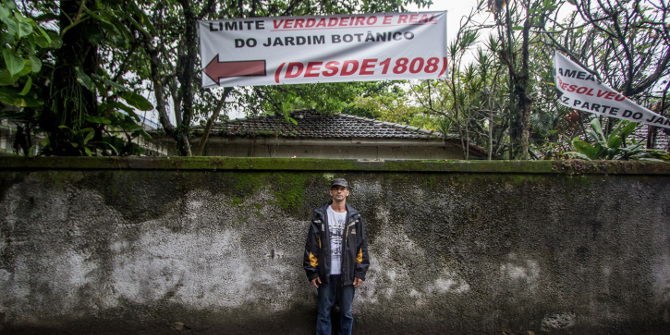
Depicting favela residents as environmentally destructive invaders serves to justify evictions and undermine community heritage in the name of creating a “modern” city free of potent signs of poverty and inequality, writes Jennifer Chisholm (University of Cambridge).
• Também disponível em português
The favelas, or informal settlements, of Rio de Janeiro have always been one of the city’s defining features. The favelas have gone through periods of zero tolerance and mass evictions, but also periods in which the city has sought to incorporate them into the more formal parts of the city.
These days, the city is doing a little bit of both. While some favelas have received urban upgrading through government programs, others have been marked for eviction. The government’s favoured rationales for these evictions are that favelas are illegally occupying land and/or that they are destroying the environment. Yet, in some instances favelas are replaced by luxury condominiums, suggesting that evictions are more about social cleansing than preserving the environment.

Favelas on private land have the option of invoking adverse possession or “squatter’s rights” that would make them eligible for land titles. However, favelas on public land can only get the right to use land, not own it — arguably making them more vulnerable to eviction. Moreover, claims of environmental degradation are especially troublesome for favelas on federally owned land, as these are often protected nature reserves.
In an effort to save their communities, activists from affected favelas have attempted to subvert the narrative of the invasive, destructive favela by divulging a counternarrative of multigenerational communities that exist harmoniously with the environment. From this perspective, the government is the true invader.
Nestled next to the Botanical Garden of Rio de Janeiro, a federal institution, is an informal settlement of families descended from workers of the garden who are currently embattled over the right to stay in their homes. This community, known as Horto (“garden” in Portuguese) sits on a site that has been occupied since the colonial era, but today it finds itself embroiled in a fight for land and housing rights. A vocal critic of Horto, Sérgio Besserman, president of the federal Research Institute of the Botanical Garden of Rio de Janeiro, objects to housing on land claimed by the Botanical Garden and envisions expanding the Institute’s premises after Horto’s eviction.
During my fieldwork in the community, residents gave accounts of the era of their grandparents and great-grandparents, when the Botanical Garden gave its workers permission to occupy land and construct their own houses nearby. Most of these workers and their families were only given verbal permission to occupy the land, which at that time the residents considered a dependable commitment.
Sadly, this lack of documentation has complicated the lives of Horto families. Over 215 of these families have been served eviction notices, whereas others have already been evicted and their houses destroyed. Since much of Horto is located on federal land, many families are unable to petition for land titles. Instead, residents and community activists are using every possible recourse to resist removal, from soliciting the support of sympathetic politicians and judges, to simply reinforcing community bonds through social projects like photography workshops and dance socials.
About two and a half hours away in the western part of Rio lies Araçatiba, a sleepy favela surrounded by a mangrove reserve. In the late 1970s, the media conglomerate Globo began filming a children’s television programme in the area, forcing the self-built housing further back from the main road and into Araçatiba’s current location. Until 2006, the area belonged to the military but it then passed to the federal government, which proceeded to create a register of Araçatiba’s buildings in 2012.
In 2014 the favela received eviction notices from the government, which accused them of invading and endangering the mangrove reserve. Shortly after, a demolition unit came to remove houses leading to a fifteen-hour standoff by residents. Two years later in December 2016, the city government notified residents that any dwellings built after 2012 were illegal and that no further construction could take place under threat of demolition, leaving these houses incomplete yet inhabited.

Accusations of invasion are especially poignant for informal settlements like Horto and Araçatiba that are located around nature reserves.
As such, Araçatiba’s residents’ association has recently tried to raise awareness of threats of imminent eviction while also preparing their case against government accusations of invasion and environmental harm. Aside from collecting relevant documents, residents are planning to create an ecological leisure area and an organic garden. These social projects intend to improve community life, but they will also serve as tangible proof of Araçatiba’s commitment to environmentalism and a rebuttal of the government’s “destructive favela” stance.
Horto residents have also taken great pains to demonstrate their concern for the environment, as they see themselves as natural-born stewards. One resident organises reforestation projects with children to teach them about local flora, while the Residents’ Commission of Horto carries out a weekly recycling drive.
But Horto, Araçatiba, and other similar favelas continue to be likened to an invasive, destructive species by those seeking their removal. Where organically developed communities have existed — and been tolerated — for generations but are suddenly subject to eviction, the question arises of who’s really invading whom.
There are several possible motivations for depicting favela residents as environmentally destructive invaders. For one, if the public believes that favela residents invaded and are destroying the land on which they live, calls for eviction become more justifiable, even in the minds of favela residents themselves. Accusations of invasion also downplay any sense of heritage that these communities have fostered, refashioning favelas as places without history and therefore worthy of eviction.
Accusations of invasion can be seen as part of larger effort to regain control of these public lands, to “reterritorialise” them. Aside from a desire to leave no part of Rio outside of government control, reterritorialisation — and the ensuing favela evictions — is also driven by a desire to “modernise” the city and erase all trace of the poverty that signifies a developing country and the inequality that defines Brazil in particular.
Governmental concern for conservation of its natural areas is understandable, but using environmental protection as a means of undermining housing rights is not. Instead of denigrating informal settlements by classifying them as illegal invasions, the state could instead seek a solution that also ensures that the housing rights of these communities are respected.
The city of Rio can afford to evict these families, but they are doing so at a time when the state of Rio de Janeiro is suffering an economic crisis. A more economical and sustainable solution — and one preferred by residents themselves — would be for the city to save itself the cost of evictions by permitting communities to stay and by forging more respectful relationships.
A first step along this more constructive path would be to end the “invader” stigmatisation of the favelas and their residents.
Notes:
• The views expressed here are of the authors rather than the Centre or the LSE
• Please read our Comments Policy before commenting






Hi ma, your write up master piece on what characterised “favela,” and their challenges in Horto and Carathiba, Rio de Janeirio, Brazil was quite informative, educating and directory. But I stand to share and bear my mind on the fact that, the idea of eviction and clearing people who’ve existf in an area/(s) for over a century when originality is traced isn’t proper, given the socio-economic austerity and hardship such a people would be left with. At this juncture, i strongly advice policy makers, city planners, allied professionals in the built environment and the government of Brazil to adopt the concept of ‘new urbanism’ and integrate them into the ‘modernisation project,’ bysodoing, it’ll reduce the burden of homelessness and originality denial.
Hi Colin,
Thanks for your reply. What constitutes a favela is hotly contested and completely subjective since there are no official governmental definitions. Moreover, given the stigma associated with the word, these communities tend not to want to be associated with it. I’m aware that there are Horto residents who don’t consider it a favela and the current president of the resident’s association once described it as undergoing “favelization” though not quite a favela. In light of the stigma, I normally translate “favela” as “informal settlement” in English, which I think describes Horto well. In my view, what makes Horto informal isn’t the architecture but their vulnerability to eviction due to a lack of property titles. I also think it’s appropriate to include Horto in discussions about favela rights because their community leaders are actively involved in the Pastoral de Favelas, a social justice organization tied to the Catholic Church that campaigns on behalf of Rio’s favelas. They also regularly mobilize with other favelas over housing rights and other issues facing favelas like police violence. My guess is that Horto adopts a favela identity when it’s politically beneficial but eschews it during these tours with outsiders, given that these tours are mainly about convincing others that Horto is a longstanding and respectable community like any other that deserves to stay.
This is an important and timely article. I enjoyed it immensely. I would, however, challenge Ms. Chsholm’s characterisation of Horto as a “favela” or even as an “informal settlement.” I’ve taken courses of Us and Brazilian students there to talk with he residents. Horto has all of the characteristics we associate with formality in much of the world – making the story she tells even more important.
I would be interested in her reply.